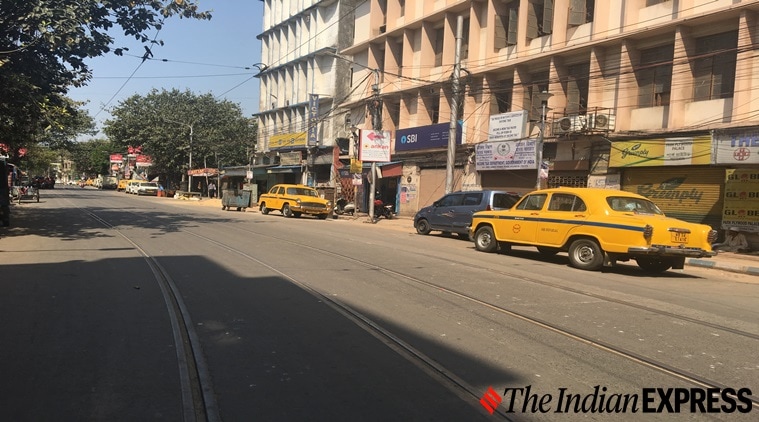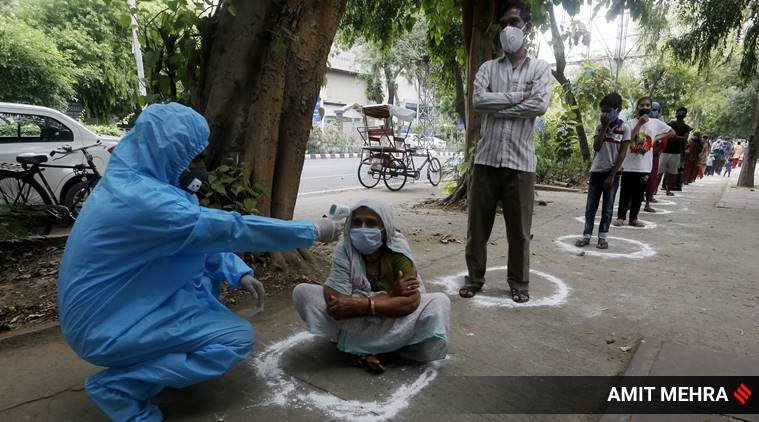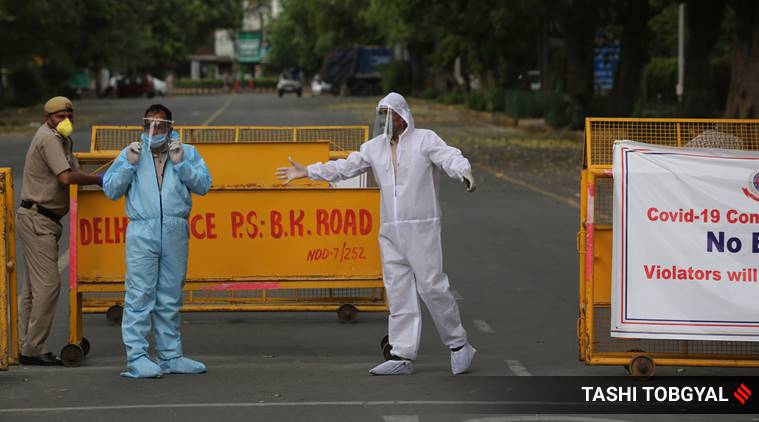 The current trajectory of confirmed cases in India points to the fact that the initial 21-day lockdown has been effective in delaying the steep rise in infections. (Express photo/Neha Banka)
The current trajectory of confirmed cases in India points to the fact that the initial 21-day lockdown has been effective in delaying the steep rise in infections. (Express photo/Neha Banka)
Written by T. M. Pranathi & Shruti Prasad
With the national lockdown coming to a close on May 3 and record highs in confirmed cases in the last one week, it is a crucial juncture to re-examine a cohesive policy pathway and come up with a viable lockdown exit strategy. While a number of states have put forth ideas on phasing out the lockdown, the emphasis should be placed on a more comprehensive and responsive exit strategy, accounting for real progress and preparedness.
The current trajectory of confirmed cases in India points to the fact that the initial 21-day lockdown has been effective in delaying the steep rise in infections. However, evolving evidence from Singapore and South Korea suggests that even countries with a robust healthcare system, rule abiding populace and prior experience with outbreaks are not completely safe from unexpected rising infections despite initial success. Logic, therefore, seems to point to a potential risk of a second-wave if the lockdown is eased before the infection peak has passed, especially in the context of countries with weak institutional infrastructures.
Follow Coronavirus India LIVE Updates
What needs to be considered for a successful exit strategy?
This article proposes a three-phased exit strategy based on the report, “Navigating To Normal: A Responsive Lockdown Exit Strategy” written by the alumni of School of Public Policy and Governance, TISS-Hyderabad. Each phase is captured by empirically verifiable indicators along with institutional requirements to realise the success in meeting the objectives of that particular phase. The states can move from one phase to another if they reflect improved indicators and effective institutional functioning. However, if they show negative performance on indicators they should revert to the earlier phase.
For a cogent argument supporting a phased approach, we will highlight the three important anchors which form the underlying basis for a staggered exit. These include: unsure outcomes of early relaxation, institutional preparedness and flexible phasing.
The Three Key Anchors
Anchor one takes into account uncertain outcomes arising from early relaxation of the lockdown. In its recent guidelines, the government has eased some restrictions on specific sectors in order to mitigate socio-economic hardship to the public. While this trade-off seems necessary at the outset, it is imperative to understand that such a move involves huge risks, given the likelihood of recurrence. The projected infections of the post 21-day lockdown by various studies such as /Center for Disease Dynamics, Economics, and Policy (CDDEP)/ and /Boston Consulting Group (BCG)/also indicate that there is a high possibility of India experiencing the peak of infections in the coming days/months. Any guided relaxation of restrictions should, therefore, be considered only after the predicted peak period has passed. Failure to do so might compel the government to impose even longer lockdowns in the later phases.
 The tourism sector has come to a standstill in the country since a nationwide lockdown was implemented on March 24. (Photo: Amit Chakravarty)
The tourism sector has come to a standstill in the country since a nationwide lockdown was implemented on March 24. (Photo: Amit Chakravarty)
Secondly, effective phasing out requires a comprehensive approach, where administrative units shift out of lockdown based on not just the predicted rise or fall in infections but also the institutional and operational capacities that should be in place. The staggered exit should, therefore, be taken as an opportunity for strengthening administrative systems, triggering medium-long term institutional changes, moving towards a more responsive pandemic control strategy and perhaps creating more resilient futures.
The third important anchor is to adopt a flexible approach to a phased exit. States can activate or remove moderate-to-strict restrictions in an adaptive manner, depending on evidence of infection rates and institutional preparedness. While temporary and short lockdowns will help in delaying the peak of infections, there is a need to bring about a permanent and sustained reduction in transmission, which will truly flatten the curve.
A Three Phased Approach
Taking into cognizance the above critical anchors, there can be a three-phased staggered exit, each indicated by ‘Rising and Peak infections’, ‘Falling infections’, and ‘Few or no infections’ respectively.
 Gujarart’s Vadodara fights off coronavirus in a unique way, also spreading the ‘Stay at Home’ message to the people. (Express Photo by Bhupendra Rana)
Gujarart’s Vadodara fights off coronavirus in a unique way, also spreading the ‘Stay at Home’ message to the people. (Express Photo by Bhupendra Rana)
While slowing the transmission of novel coronavirus with adequate focus on ‘flattening the curve’ remains the primary goal of each phase – actionable measures such as augmenting existing infrastructure and developing temporary healthcare capacities; providing immediate relief for hard-hit sectors and vulnerable populations; and ensuring robust contact tracing and surveillance mechanisms are pivotal in achieving the goal.
With growing apprehensions about community transmission in addition to rising cases of asymptomatic individuals testing positive, it is indispensable to administer vigorous testing mechanisms, preferably at an exponential rate. States should, therefore, strengthen the testing capacities to cover wider sections of populations. To this effect, private players should be adequately incentivised by the government to provide affordable testing.
As the crisis unleashes a disproportionate burden on the poor and vulnerable, it is important to ensure that quarantining measures go beyond mere provisioning of shelters. In other words, adequate emphasis should be placed on essential social and infrastructural amenities. Although the government has issued interim guidelines on the functioning of state quarantine facilities, there is a pressing need to ensure its ground level implementation.
Sustained efforts towards slowing the spread while simultaneously advancing towards a complete exit, demand attempts to go beyond ‘flattening the curve’, implying the need for ‘raising the line’ i.e. filling in institutional and infrastructural shortages. While the former includes immediate measures, the latter involves medium-to-long term interventions. These include enhancing and building of robust healthcare infrastructural facilities; establishing Public Health Emergency Preparedness systems; sustained in-house production of medical supplies; regulating and enforcing health & hygiene protocols in workplaces; mitigating the ever existing problem of understaffing; and capacity building of community health workers at ground level.
The above two synergistic aspects concerning ‘flattening the curve’ and ‘raising the line’ indicate that any incidence of recurrence or spike in infections, increased community / unidentified transmission, overburdened healthcare systems, sub-optimal institutional and infrastructural capacities will necessitate the need for ‘Adaptive triggering’. In a nutshell, if infection rates rise or there is inadequate institutional and infrastructural preparedness, States should have the flexibility and means to fall back into a previous phase.
 Poor and needy persons being served food at a Delhi congress office during ongoing COVID-19 lockdown in New Delhi, Thursday.
Poor and needy persons being served food at a Delhi congress office during ongoing COVID-19 lockdown in New Delhi, Thursday.
In order to exit the suppression loop and move beyond Phase 3, there needs to be continued efforts towards pandemic control at the micro, meso and macro levels. To this effect, real-time monitoring of transmission should be effectively carried out which will aid in informed timely decision making as well as district level plans for containment and recovery.
Post Covid Institutional Resilience
For sustained pandemic control as well as resistance to crisis and shocks, it is important to transcend from immediate results to real institutional resilience. Long-term structural and institutional changes include strengthening public health expenditure; establishing Medical Emergency Response Teams which requires coordination as well as convergence among Health personnel, Police, and NDMA. Furthermore, there is a need for institutionalising robust social security models, including portability of entitlements and nutritional security; and institutionalising civic solidarity for a more proactive and far-reaching response to any crisis.
 Police patrolling during the nationwide lockdown.
Police patrolling during the nationwide lockdown.
This crisis brings home the most significant lessons of enriching and expanding foundational infrastructures, institutional interdependence, and responsive governance which are pivotal to inclusive and constructive public policy.
The writers are alumni of School of Public Policy and Governance.